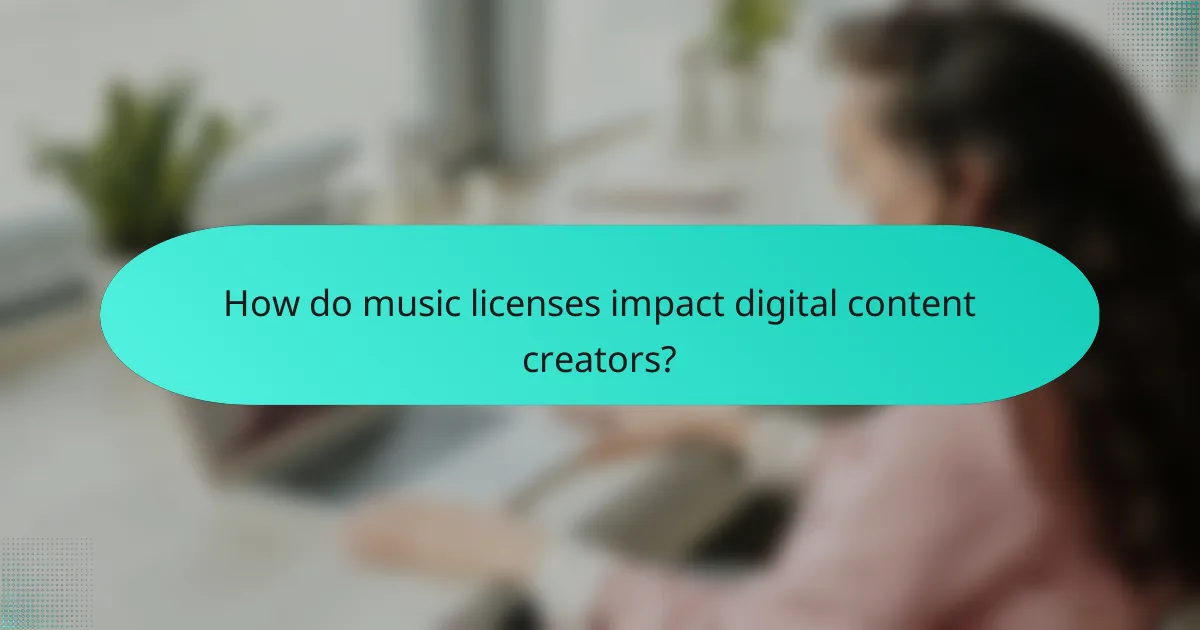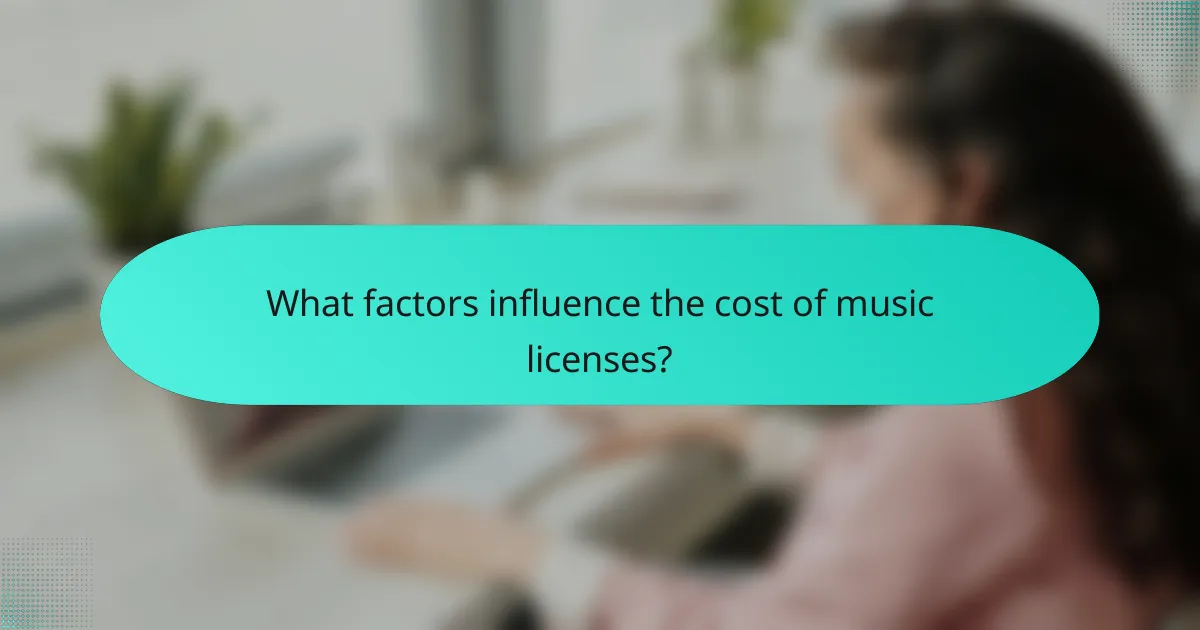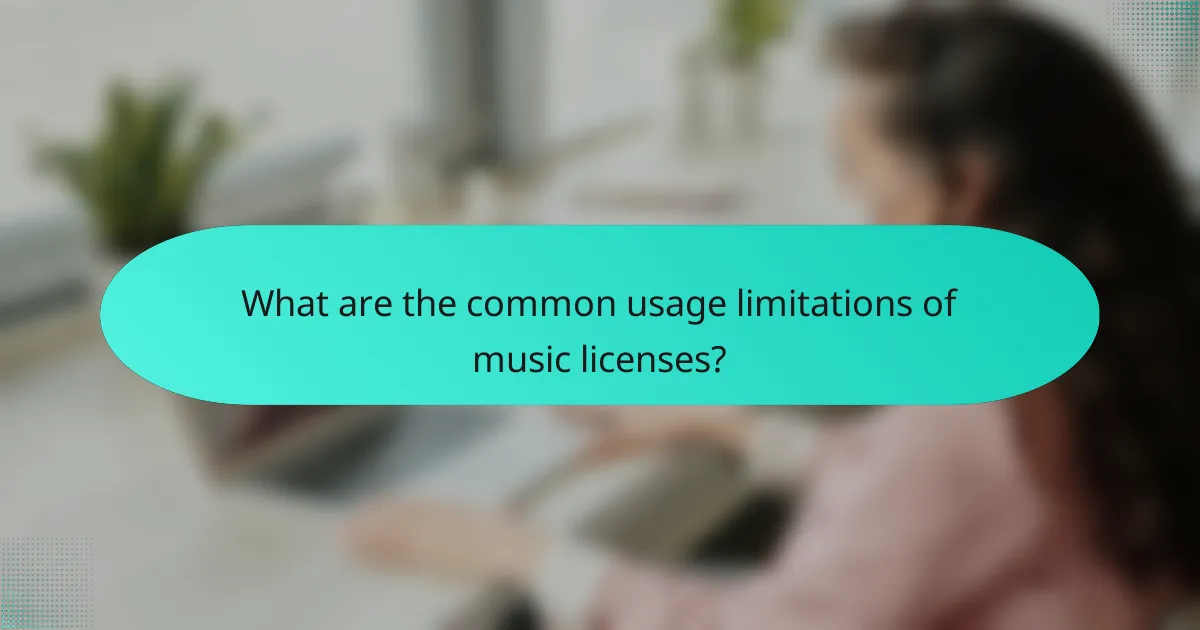Music licenses play a vital role in determining how music can be used across various platforms, from films to public performances. These licenses not only outline the rights and limitations associated with music usage but also introduce variability in costs based on factors such as duration, popularity, and negotiation terms. For content creators, navigating this complex landscape is essential for making informed decisions that impact both their creative endeavors and financial outcomes.

What are the types of music licenses available in the US?
In the US, music licenses can be categorized into several types, each serving different purposes and rights. Understanding these licenses is crucial for anyone looking to use music in various contexts, from film to public performances.
Synchronization licenses
Synchronization licenses are required when music is paired with visual media, such as films, TV shows, or online videos. These licenses grant the right to synchronize a piece of music with a visual element, allowing creators to legally use the song in their projects.
The cost of synchronization licenses can vary widely, often ranging from a few hundred to several thousand dollars, depending on the song’s popularity and the project’s scope. It’s essential to negotiate terms that align with your budget and usage needs.
Mechanical licenses
Mechanical licenses are necessary for reproducing and distributing music, particularly in physical formats like CDs or digital downloads. This type of license allows you to create copies of a song and sell them, ensuring that songwriters and publishers receive royalties.
The cost for mechanical licenses is typically calculated based on the number of copies produced, often set at a statutory rate per unit sold. For example, in the US, the rate is around 9.1 cents per copy for songs under five minutes long.
Public performance licenses
Public performance licenses are needed when music is played in public spaces, such as restaurants, bars, or events. These licenses ensure that the rights holders are compensated for the public use of their music.
Costs for public performance licenses can vary depending on the venue size, type of music, and the licensing organization. Businesses often obtain these licenses through performance rights organizations (PROs) like ASCAP or BMI, which typically charge annual fees based on estimated revenue or attendance.
Master licenses
Master licenses are required when using a specific recording of a song, as opposed to the song itself. This license is essential for anyone looking to use a particular version of a track in their projects, such as films or commercials.
The cost of a master license can be quite high, especially for well-known recordings, and is often negotiated directly with the record label or rights holder. Factors influencing the price include the song’s popularity and the intended use.
Sample licenses
Sample licenses are necessary when incorporating a portion of an existing recording into a new work. This type of license covers the legal use of a sample, ensuring that the original artist and rights holders are compensated.
Obtaining a sample license can be complex and costly, as it typically involves negotiating with both the original artist and the publisher. Fees can vary significantly based on the sample’s length and the prominence of the original work, often reaching thousands of dollars.

How do music licenses impact digital content creators?
Music licenses significantly affect digital content creators by dictating how they can use music in their projects. These licenses determine the rights, costs, and limitations associated with music usage, which can influence both creative choices and revenue potential.
Rights management for streaming
Rights management for streaming involves understanding the specific permissions required to use music in online content. Creators must obtain licenses that cover performance rights, mechanical rights, and synchronization rights, depending on the platform and usage type. For instance, platforms like YouTube and Twitch have distinct licensing agreements that creators must comply with to avoid copyright infringement.
When streaming, it’s essential to differentiate between licensed and unlicensed music. Using unlicensed tracks can lead to content removal or account suspension, while licensed music often comes with fees that vary based on the track’s popularity and the intended use.
Monetization strategies
Monetization strategies for content creators using music hinge on the type of licenses they secure. Creators can either pay for licenses upfront or explore revenue-sharing models, where they split earnings with rights holders. For example, using royalty-free music can minimize costs while still allowing for monetization through ads or subscriptions.
It’s crucial to evaluate the cost-benefit ratio of different licensing options. Some platforms offer subscription services that provide access to extensive music libraries for a flat fee, which can be more economical for frequent users compared to individual track purchases.
Legal compliance requirements
Legal compliance requirements for music licenses vary by region and platform, making it essential for creators to stay informed. In the U.S., the Digital Millennium Copyright Act (DMCA) outlines the legal framework for copyright in digital media, while other countries have their own regulations that may impact music use.
Creators should maintain records of all licenses obtained and ensure they understand the terms, including any limitations on usage duration or geographic restrictions. Regularly reviewing compliance can help avoid costly legal disputes and ensure that content remains accessible and monetizable.

What factors influence the cost of music licenses?
The cost of music licenses is influenced by various factors including the type of license required, the duration of usage, the popularity of the music, and the negotiation terms. Understanding these elements can help you estimate potential expenses and make informed decisions.
Type of license required
The type of music license you need significantly affects the cost. Common licenses include synchronization licenses for film and TV, mechanical licenses for physical copies, and performance licenses for public plays. Each type has its own pricing structure, often based on the intended use and distribution scale.
For example, a synchronization license for a popular song in a major film can cost thousands of dollars, while a mechanical license for a small indie project may only be in the low hundreds. Assess your project’s needs to determine the appropriate license type.
Duration of usage
The duration for which you intend to use the music also impacts licensing costs. Short-term licenses for specific events or projects are generally less expensive than long-term agreements that cover extended periods. For instance, a one-time use for a commercial may cost significantly less than a multi-year license for ongoing use.
When negotiating, clarify how long you need the music to avoid unexpected fees. Some licenses may offer discounts for longer commitments, while others may charge a premium for short-term access.
Popularity of the music
The popularity of the music plays a crucial role in determining licensing fees. Well-known tracks by famous artists typically command higher prices due to their demand and market value. In contrast, lesser-known or independent artists may offer more affordable licensing options.
Consider exploring a mix of popular and emerging artists to balance costs. Licensing a hit song might enhance your project’s appeal, but it could also strain your budget. Weigh the benefits against the financial implications.
Negotiation terms
Negotiation terms can greatly influence the final cost of music licenses. Factors such as exclusivity, territory, and rights granted can lead to variations in pricing. For example, an exclusive license that prevents others from using the same track will typically be more expensive than a non-exclusive agreement.
Be prepared to negotiate terms that align with your budget and project goals. Establishing clear communication with rights holders can lead to more favorable agreements, potentially saving you money while securing the music you need.

What are the common usage limitations of music licenses?
Music licenses often come with specific usage limitations that dictate how and where the music can be used. These restrictions can include geographic areas, types of media, and timeframes, which are crucial for ensuring compliance and avoiding legal issues.
Geographic restrictions
Geographic restrictions specify the locations where the licensed music can be used. For instance, a license might allow usage only within a particular country, region, or even specific cities. This is particularly relevant for music intended for local broadcasts or events, where rights may vary significantly across different territories.
When negotiating a license, it’s essential to clarify these geographic limitations to avoid potential breaches. If you plan to distribute content internationally, ensure that your license covers all intended regions.
Medium-specific limitations
Medium-specific limitations define the types of platforms or formats where the music can be utilized. For example, a license may permit use on digital streaming services but prohibit broadcasting on television or radio. Understanding these limitations is vital for content creators who aim to use music across various media.
Always check the license terms to ensure that your intended use aligns with the permitted mediums. If your project evolves, you may need to secure additional licenses for different formats.
Timeframe constraints
Timeframe constraints outline the duration for which the music can be used under the license. This can range from a specific number of months to a perpetual license that allows indefinite use. Knowing these time limits helps in planning your projects and budgeting for potential renewals.
Be proactive in tracking the expiration of licenses, especially for projects that may extend beyond the initial timeframe. Renewing licenses in advance can prevent disruptions in your content availability.
